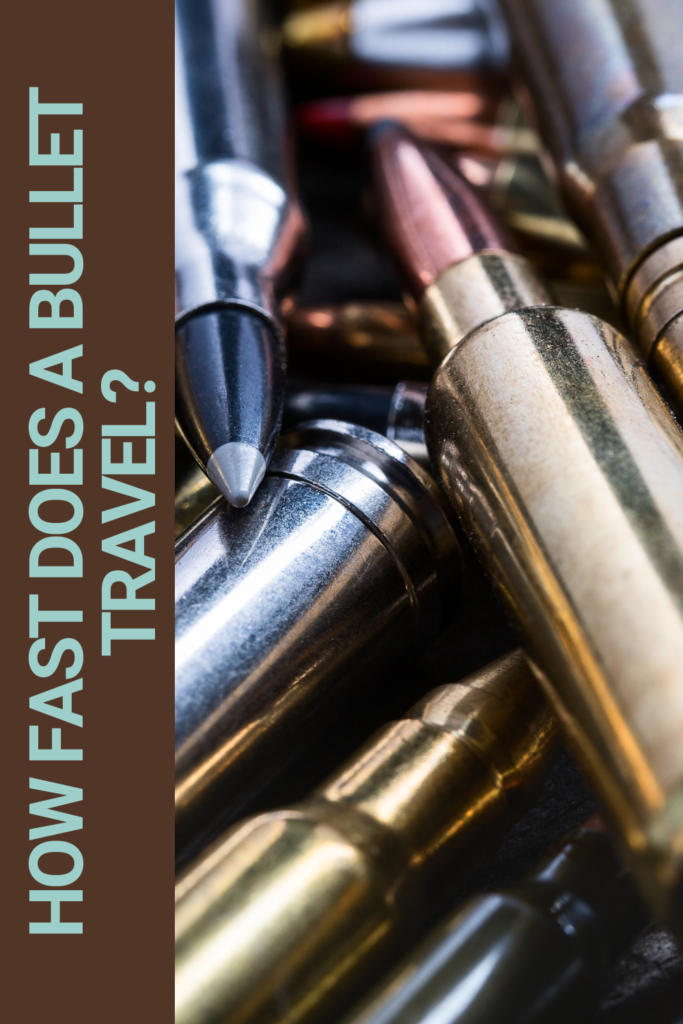How fast does a bullet travel? Buckle up, because we're about to break down the need-for-speed mysteries behind bullet speed. Ever wondered why some bullets zip through the air while others are slower? Get ready to uncover the secrets and dive into the fast-paced world of bullet speed.

How Fast Does a Bullet Travel: The Basics of Speed
I've always been fascinated by the sheer speed that bullets fly, and it turns out, there's more to it than meets the eye. When we talk about how fast a bullet travels, we know it's the combination of precision and power.
Nuances matter. The caliber of the firearm sets the stage, determining the bullet's journey. It's the first part of velocity, where powder load adds the oomph, and barrel length directs the range. It either works together seamlessly or well, with an occasional inconsistency for one reason or another.
It's not just about how fast, but why and how each element contributes to the final ballet of motion that propels a bullet from the barrel to its target.
Breaking Down the Need for Speed
Now, imagine you're at the range, the anticipation building as you line up your shot. You squeeze the trigger, and there it goes – the bullet catapults forward with a burst of speed.
But what dictates this acceleration? Enter the world of firearms. Handguns, with their compact design and nimble handling, have a distinct flair for speed. Rifles, precision instruments with longer barrels, unleash a different kind of velocity. Shotguns, favored for their versatility, bring their own unique dynamics to the speed game.
Read More: When You Defend Yourself, Who Defends You: Right to Bear
Each firearm type has its own personality and its preferred rhythm of releasing bullets into the world.
Ever wondered why your trusty pistol feels different from shouldering a rifle? It's not just about the shape – it's about the physics at play.

Comparing Caliber Speeds
Let's dive into the heart of the high-speed showdown – the world of calibers, where the size and weight of your bullet can dramatically alter the dynamics of its flight.
Picture a .50 caliber, a heavyweight contender that commands attention with sheer power. Now, contrast that with the sleek and nimble 9mm, valued for its speed and agility.
The caliber of your firearm is not just a number; it's a defining characteristic that influences the very essence of bullet speed.
Handgun/Pistol Ammunition Speeds:
.22 Short: Around 1,045 fps
.22 Long Rifle (.22LR): Varies, but typically around 1,200 fps
.22 Magnum (.22 WMR): Around 1,800 fps
.25 ACP (6.35mm): Around 760 fps
.32 ACP (7.65mm): Around 900 fps
.380 ACP (9mm Short): Around 1,000 fps
9mm Luger (9x19mm): Around 1,150 – 1,200 fps
.38 Special: Around 800 – 1,000 fps
.357 Magnum: Varies, but often around 1,500 fps
.40 S&W: Around 1,000 – 1,200 fps
10mm Auto: Around 1,200 – 1,400 fps
.45 ACP (11.43mm): Around 800 – 1,000 fps
.44 Special: Varies, but often around 900 fps
.44 Magnum: Varies, but often around 1,400 – 1,600 fps
.45 Colt (11.43x33mm): Varies, but often around 800 – 1,000 fps
.454 Casull: Around 1,600 – 1,800 fps
.460 S&W Magnum: Around 1,800 – 2,200 fps
.500 S&W Magnum: Around 1,400 – 1,800 fps
Shotgun Ammunition Speeds:
.410 Bore: Varies, but often around 1,200 fps for shot and 600 fps for slugs
20 Gauge: Varies, but often around 1,200 – 1,300 fps for shot
16 Gauge: Varies, but often around 1,200 – 1,300 fps for shot
12 Gauge: Varies widely depending on the load, but can range from 1,200 to 1,600 fps for shot
10 Gauge: Varies widely depending on the load, but can exceed 1,600 fps for shot
Rifle Ammunition Speeds:
.223 Remington: Around 3,000 fps
.243 Winchester: Around 2,900 – 3,100 fps
.270 Winchester: Around 2,900 – 3,100 fps
7mm Remington Magnum: Around 2,900 – 3,100 fps
.30-30 Winchester: Around 2,200 – 2,600 fps
.308 Winchester: Around 2,600 – 2,900 fps
.30-06 Springfield: Around 2,600 – 2,900 fps
7.62x39mm: Around 2,100 – 2,400 fps
.300 Winchester Magnum: Around 3,000 – 3,200 fps
.338 Lapua Magnum: Around 2,800 – 3,100 fps
.50 BMG: Around 2,800 – 3,000 fps
Bullet Velocity in the Real World
Now, let's transition from the theoretical to the tangible, bringing the discussion about bullet velocity into real-world marksmanship. Have you ever been captivated by tales of sharpshooters making crazy awesome shots? It's not merely a display of skill; it's a mastery of understanding the intricate dance between ballistic trajectory and bullet velocity.
Imagine a sniper perched on a distant rooftop, eyeing a target with precision. The shot isn't just a pull of the trigger; it's a calculation of knowledge and skill. This is where the practical implications of bullet speed come to life.
Bullet velocity refers to the speed at which a projectile, typically a bullet, travels through the air. It is usually measured in feet per second (fps). The velocity of a bullet is a crucial factor that influences its performance and behavior.
Here are some key points about bullet velocity:
- Initial Velocity: When a bullet is fired from a firearm, it starts with an initial velocity, which is the speed at the moment it leaves the muzzle of the gun. This velocity is influenced by various factors, including the type of firearm, the length of the barrel, the type of ammunition, and the amount and type of gunpowder used.
- Ballistic Characteristics: The velocity of a bullet affects its ballistic characteristics, such as trajectory, accuracy, and range. Higher velocities generally result in a flatter trajectory, meaning the bullet will drop less over a given distance. This can be important for long-range shooting.
- Terminal Ballistics: The velocity of a bullet also plays a crucial role in its terminal ballistics, which refers to the bullet's behavior upon impact with a target. Higher velocities can contribute to greater energy transfer and more significant damage to the target. However, factors like bullet design, construction, and weight also influence terminal ballistics.
- External Factors: External factors, such as air resistance (drag), can slow down a bullet as it travels through the air. This is why manufacturers often provide muzzle velocity, which is the speed of the bullet at the moment it leaves the barrel. As the bullet travels downrange, its velocity decreases.
- Units of Measurement: Bullet velocity is typically measured in feet per second (fps) in the United States or meters per second (m/s) in many other countries. The velocity is often indicated on ammunition boxes or in firearm specifications.
- Importance in Firearm Selection: The desired velocity is an important consideration when selecting ammunition or a firearm for a particular purpose. For example, hunters may choose ammunition with a specific velocity to ensure effective shot placement and energy transfer, while target shooters may focus on ammunition with consistent velocities for accuracy.
It's important to note that bullet velocity is just one of many factors that influence the performance of a bullet, and it should be considered in conjunction with other factors such as bullet design, caliber, and the intended use of the ammunition.
Commonly Asked Questions About Bullet Speeds:
How fast does a bullet travel in mph?
Bullets typically travel at speeds ranging from approximately 700 mph to 3,000 mph. The exact speed depends on factors such as the caliber of the bullet, type of firearm, and ammunition used.
How fast does an AK-47 bullet travel?
The AK-47 fires 7.62x39mm rounds, which generally travel at speeds between 2,100 mph and 2,400 mph. This assault rifle is known for its reliability and widespread use.
How fast does a 9mm bullet travel?
A 9mm bullet commonly travels at speeds ranging from 1,150 mph to 1,200 mph. The 9mm caliber is popular for its balance of manageable recoil and stopping power in handguns.
What is the average speed of a bullet?
The average speed of a bullet varies widely based on caliber and firearm type. Generally, handgun bullets range from 700 mph to 1,500 mph, while rifle bullets can exceed 3,000 mph.
How fast does a bullet travel?
As we wrap up this journey into the world of bullet velocities, one thing becomes clear – speed is not just a number; it's a dynamic force that shapes the art and science of marksmanship. So, the next time you ask, “How fast does a bullet travel?” you'll not only have the answer but a newfound appreciation for the intricacies that make each shot a high-speed adventure.
